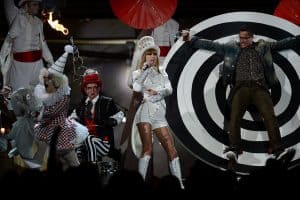Since the dawn of time (animation time at least), people who aren’t in the know have categorised Japanese anime and American cartoons under the umbrella term of ‘animation’, expecting them both to cater to younger audiences with no real depth of character growth or narrative impact. After all, both are made using the same animated mediums, so therefore both of them must have the same target demographics, emotional depth, quality, and purposes, right?
Wrong, sir, wrong! Comparing Japanese anime to American cartoons is like comparing a cheeseburger to a pizza. Yes, both use cheese. Yes, both of them are bread-based cuisines. Are they even remotely similar beyond this? No! Will we flip tables if people imply otherwise? Yes! Japanese anime and American cartoons have been like chalk and cheese since the original cartoons started to become popular in the late 80s and early 90s, but what are the differences really? Why do super nerds get twitchy eyes if you dare to mention The Simpsons and Dragon Ball in the same breath?
Emotional Depth As A Rule
There are some American cartoons that really hit the emotional mark when it comes to meaningful storytelling. Take Teen Titans, for example, the original 2003 masterpiece, not the revamped Teen Titans Go! Teen Titans explores realistic, sometimes tragic themes such as isolation and abandonment, masking true feelings, obsession, and the definition of villainy. Similarly, Bojack Horseman pushes the bounds of adult animation by locking in to exploring psychology with no filters. For the most part, these cartoons are the exception to the unwritten rules of American cartoons, but why is that?
That Illusive Target Demographic
It all depends on who the cartoons are being written for. In America, the majority of cartoons are still being written for younger audiences. The bright colours and absurd proportions of the characters lend themselves to the unrealistic expectations of child play so series like SpongeBob SquarePants, The Powerpuff Girls, and earlier examples like Tom and Jerry work on a shorter, one-episode narrative system that doesn’t leave room for a lot of thought-provoking exploration. It caters to an audience less likely to come back for a follow-through saga and for those with less power over their schedules.
What about adult animation? I hear you crow. Overall, we have a much wider range of adult animation than we ever have had before, including breakout series like Arcane and Vox Machine, also the Mighty Nein when it drops in November 2025 but in a sea of adult animation, we can really only count on one hand those that push emotional boundaries and rely on more of a saga-like structure. Adult animation is still dominated by the likes of The Simpsons, Family Guy, and American Dad, which take a far more light-hearted, if sometimes more darkly humorous tone and still fall within that one-episode narrative system to zero in on entertainment rather than emotional enrichment.
Anime Pacing
Japanese anime tend to work on the reverse, and their target audiences don’t swing so wildly from one to the other. For the most part, anime seems to be aimed at older teens, so the issues presented within their contents tend to be more complex, tend to explore saga-structures and character growth that may take several seasons to set up. Elements of elaborate intrigue are set up and explored, and anime doesn’t tend to shy away from a truly genuine emotional reaction as American cartoons do through their pointed over-exaggeration or lack thereof of expression.
The attention to narrative detail tends to be immaculate, including character traits and ticks, far more subtle psychological explorations, and moments intended to shock older audiences (see Attack on Titan and Seraph of the End for details). Similar to American cartoons but on the opposite end of the spectrum, there are those anime that don’t want to build on emotional depth or use a one-episode narrative structure, such as Shin Chan or Mushi-shi, but these are very much exceptions to that rule and noticeable for this choice.
Art Style And Aesthetics
Generally speaking, Japanese anime tend to adhere to stricter standards of anatomical correctness than American cartoons. Again, there are exceptions, such as the Naruto vs. Nagato fight in Naruto Shippuden, which had more pioneering elasticity in the character’s movements, and which turned heads in the anime industry. The rule is generally there to preserve the integrity of the more serious narrative, but it does depend on the material and that pesky demographic as to how much they tend to push the boundaries.
American cartoons are much looser in this respect, stretching out their characters’ limbs to physically impossible proportions, using more movement to convey expression, and completely changing art style mid-episode to make their once adorable protagonist look like something out of a horror movie. Yes, I’m looking at you, SpongeBob. Interestingly, superhero American cartoons tend to lock in to more anatomical correctness, but the seriousness of the subject matter covered, and the more widespread use of a more solemn saga-like structure, is more akin to the ideals upheld in anime.
Creating An Immersive Atmosphere
Brighter colours with a more 2-dimensional background are eye-catching. Considering American cartoons tend to cater more to young children, it makes sense to provide simple character designs with flat but bright colours so they’re easy to follow and hold the attention of an audience more likely to wander off.
Japanese anime are generally more inclined to be pickier about colour palettes and provide more detailed backdrops so their characters are as much a part of their world as possible. Adult American animation does pull on this more now, but the lines are blurring with more modern adaptations of things. The further back you go, the more it seems that these things are distinct. Japanese anime holds a grittier perspective, an emphasis on wowing their audiences using the laws of physics to their advantage, rather than disregarding them, and even going so far as to use the depth of the lines drawn to convey something about their characters and the places those characters inhabit.
The Best Anime And Cartoon Recommendations
The cool thing about animation, and yes, we’re using that as an umbrella term, don’t come for us, is that there is something for everyone. You don’t need to be an avid Dragon Ball fan to enjoy Japanese anime; there are love stories like My Little Monster and Say, I Love You. There are slice-of-life stories like Nana, or Nodame, and sci-fi epics like Outlaw Star and Ghost in the Shell.
The American cartoons are the same. You have choices like Rick and Morty, Infinity Train, and Adventure Time, all of which delve into more adult themes, alongside the one-episode comedy shows like Loony Toons, Ed, Edd, and Eddy, and Invader Zim (a cult classic all on its own). There are beautiful new age animations like Over The Garden Wall and The Owl House that aim to tell harder stories and that lean in to that all-important, more detailed and immersive aesthetic to give a stronger experience of the world, whilst using the maleable proportions and more elastic expressions to confirm that, yes, these are still cartoons.
The lines are blurring as time marches ever on, and perhaps, soon, there really won’t be a way to differentiate between Japanese anime and American cartoons. For now, though, the differences are still stark enough to evoke a prickly response if the two are mentioned to illustrate that animation, as a whole, is just for kids or something similar.







